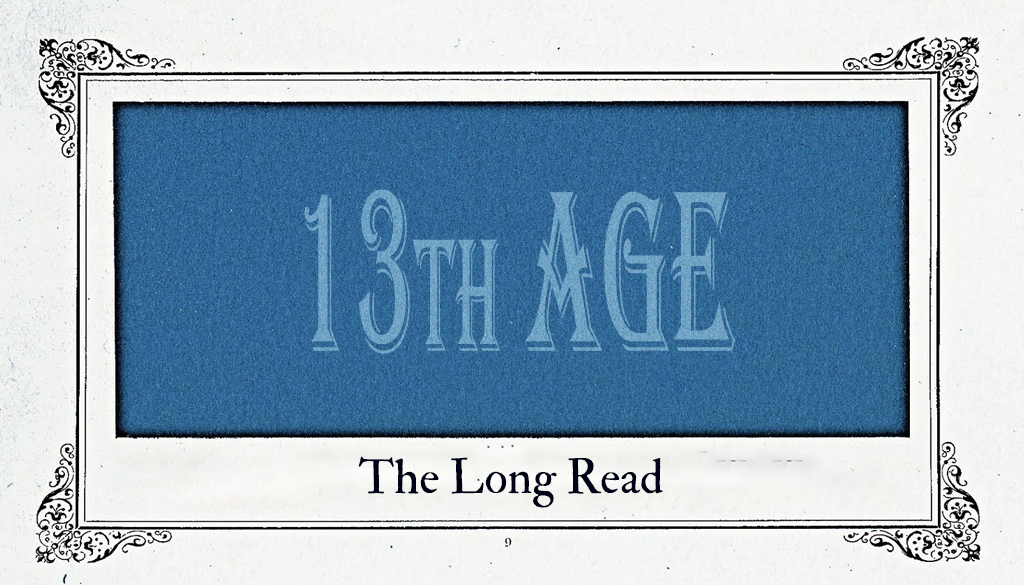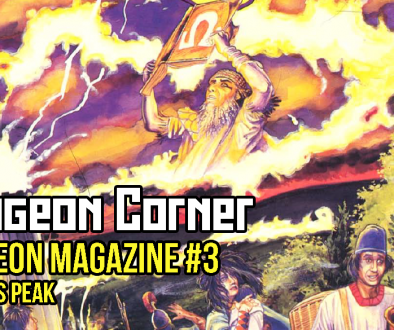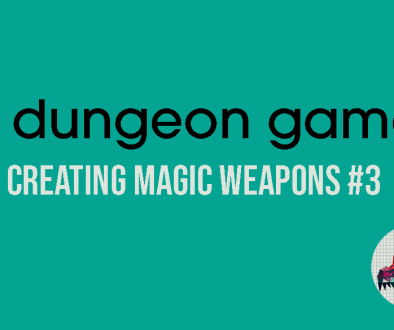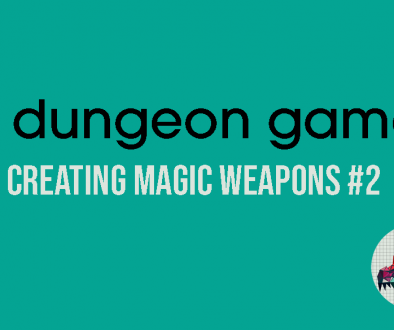The Long Read: 13th Age
This is a mirror of this Twitter thread, which was written in real time as I read 13th Age. It hasn’t been edited in any way. If you decide to pick up 13th Age from Amazon or DriveThru I’d appreciate it if you considered using one of my affiliate links, which let me earn some money from your purchase. You can also leave a tip at Ko-Fi if you like this kind of content and want to see more of it. Thanks for reading.
I’ve had 13th Age sitting on my shelf for a long time now. I picked it up because Eyes Of The Stone Thief is one of my favourite adventures and I wanted to dig into the system. I’ve never opened it.
Today I’m going to take a look at it.

As with the Pathfinder 2 thread the other week, this is just my initial impressions. It’s not a review – it’s reading the book and reacting in real time. I haven’t done any prep for this. I’m going to talk about what I like. I’m going to talk about things I might not like.
I may get things wrong. Don’t be a dick if that happens. Here’s what I know about 13th Age before I open the book:
Rob Heinsoo was the lead designer of D&D 4e, a game I’ve never played but am very interested in.
Jonathan Tweet was the lead designer of D&D 3e, a game I know very well. I know it’s a d20 game. I’m expecting to see a lot of stuff I recognise, because it’s got D&D in its DNA.
I’m actually really curious to dig in to this. (If I don’t reply to you, that’s because I’m reading. I’m already seeing a lot of “this is my favourite D&D” though, which is encouraging!)
This TOC is BIG, stretching on to two spreads. I have no idea what Icons are yet, obviously; my immediate thought was “this is what we’re calling Classes” but I see the word Class under Character Rules so I guess not. Curiosity piqued.

And we’ve got monsters in the core rulebook.
13th Age, I already like you.

“It used to be that if you wanted to play a game that intentionally engaged the players at the level of character and story, you had to play a non-d20 game” is a sentence I wouldn’t dare write on twitter.
I feel like they’re positioning this as a d20 story game. We’ll see. Okay, we’ve got our first hint at what Icons are in the introduction.
It’s an interesting decision to lead with the big, powerful characters in the setting before we get to character creation or rules. The chapter overview is really good. It’s got me excited about the stuff in this book.
In particular I’m interested in “one unique thing” – which I vaguely remember oeolle mentioning to me before – and the way magic items work, which sounds very fun. And we get an intro adventure in the core rulebook, too!
Good work, 13th Age. I love these two paragraphs. Just straight up addressing the pair of elephants in the room.

There’s some personality in the writing in this book, too. I don’t feel like I’m reading dry rules text. I feel like I’m reading something written by someone who’s excited to share it with me. I’ve seen the word “hellhole” twice now and I can’t wait to find out what they actually are, given I also know that living dungeons exist in this setting (because Eyes Of The Stone Thief)
The Dwarf King gets done dirty here. I feel like his entry is half as long as the others.
It sort of feels like he’s only here because people expect dwarves in a trad fantasy setting and so the designers put them in it, but had nothing interesting to say about them. This is just really boring, isn’t it?
Which is a shame because the stuff that came before it is making me really interested in this setting and the kinds of adventures you could have in it.

The True Danger section of the Dwarf King is fun, though.
“Everything will be all right provided the Dwarf King doesn’t unseal the Hall of Vengeance and retrieve the legendary Axe of Seven Bloods.”
Why? What’s that’s about? I’m in. Give it to me. (Stray thought that I’ve had Axe Of The Dwarvish Lords on my shelf for about 20 years and still haven’t ever had a chance to run it.)
Same thing with the Elf Queen on the next page. It feels perfunctory, like there has to be an Elf Queen so they just wrote one up quickly.
These are the NPCs that define the setting so it’s strange to see some of them given short shrift. I’m sort of enjoying the page that basically says, “yeah we don’t like alignment either but if you’re going to use it we can’t stop you”.
It’s clear the designers know what D&D players are like. We’re on to character creation. I was expecting crunch, but looking at the character sheet I don’t think that’s what we’re getting (though obviously I haven’t read any further yet).
This is not at all intimidating, though, which is very nice.

“Races work like normal, except that you have an option as to which ability gets your racial bonus.”
Have we done away with bioessentialism? In 2013? Surely not.
I suspect it’ll be “pick one of these stats” rather than “put it anywhere” but I’m ready to be surprised. I assume I’m not the first person to realise that you can immediately make a 13th Age game super queer by making your One Unique Thing “my character is cishet”. Mildly disappointed by the fact that the classes are standard D&D fare BUT it’s also completely understandable because this is just a version of D&D. Not everything has to be new and exciting and it’s obviously important to the designers that D&D players can pick this up easily. Twice in as many pages the book has said, “roll for abilities or use point buy, we literally don’t care and neither should you” and I respect that.
I like this paragraph about it a lot.

I’ve mentioned this already but I really like the tone of this book. It’s literally just saying, “Hey, we made a game and we think you should play it. Let us tell you about it.”
This system of finding the middle value among three stays to determine your AC and defences is weird and I can’t decide how inferlt about it.
It’s definitely not very intuitive or easy to remember. I wonder if the value you use changes as you level and your scores change or if you always use the value from the same stat once you’ve selected it at character creation? I guess I’ll find out. Ahh okay, you increase it by +1 at each additional class level. So you only need to work it out once, which is straightforward.
Still an unusual way of doing it but I guess it helps balance characters out when there’s a wide spread of stat values at first level. Back to One Unique Thing.
One of the examples is “I am a former cultist” and I’m going to spend some time thinking about the ramifications of that for a campaign world. Backgrounds present themselves as “instead of skills” but, let’s be honest here, they’re just skills under a different name and made vaguer or more broadly applicable.
Which is fine, and I prefer it to an endless list of very specific skills. And obviously I’m reading this with the benefit of nearly a decade of games that have come after this. I don’t know how novel this was at the time – I was still playing 3.5 and Advanced Fighting Fantasy and hadn’t really branched out. But anyway, yes, skill lists do one of two things: either the continue growing and getting more and more specific as you try to account for more things, or you shrink it and make them broader and more widely applicable. That seems to be what 13th Age has done. I do enjoy that they’re encouraging players to just invent their own backgrounds, though. That’s not something I expected to see in a d20 game, especially not one this old. I like it, though I can see people who only know 3e etc bouncing off it at first. I say that as I picture me, ten years ago, coming to this straight from 3.x and being told, “There’s no skill list, just make something up”.
I love it now but it would have taken some adjustment for me then. And that’s fine!
Tell me you’re reading a decade-old book without telling me you’re reading a decade-old book:

It’s always funny when I see people coming up with convoluted homebrew systems to introduce degrees of success to D&D and I like the fact that 13th Age doesn’t bother with trying to make it granular. It’s just tacking “add a complication” on to how to interpret a failed roll. One of the examples of this gets very close to saying “play to find out what happens” in fact.

Something that’s come up in our Brindlewood Bay game is that some players used to trad ganes really bounce off the idea of the GM not having all the answers and the world not really existing until the dice hit the table and define it. And that’s now, in an age where PbtA games have been around for a decade. Apocalypse World was only 3 years old when 13th Age was released.
I bet some people bounced off this. (And, again, this isn’t a criticism of the game. I’m just musing about things.)
We’re up to the races section and no, we haven’t done away with bioessentialism yet. (And again, that’s fine, this is a decade old and it’s still in 5e so, yknow.)
Players gain a bonus to one of two stats based on their race, with another bonus coming from their class.

Where the bonuses fall for each race is very unsurprising. It’s a trad fantasy game. You largely know what you’re getting. I really like the elven racial feats a lot. They do a great job of selling the idea of supernatural grace and speed.
I also really like how a lot of these racial feats interact with the escalation die (which hasn’t been explained yet in the text but I’m passingly familiar with)
Okay, I’m putting this down for half an hour while I get some food and then I’ll jump back into the classes.
First impressions: I like the tone and the clarity of writing, and I’m surprised by how little crunch there is so far. It’s like a d20 story game. I like it. And I’m back.
Time to dig in to Classes. The section on Spell Progression is, obviously, very useful but I feel it would be better served by using clearer examples – e.g. this paragraph about how resist energy changes at higher levels would be much more useful if we saw the lower level version of the spell earlier

I really like the class-specific damage dice. Weapons tend to go one of two ways in trad games – either you have a big list of things that are all largely the same and so picking a weapon is mostly flavour, or they’re all different and there’s a clear Best Choice. Saying “you use weapons! Here’s how much damage you do with them; skin its appearance as you see fit” is basically my favourite way to handle weapons so I’m glad to see it here. With the caveat that I haven’t yet read the combat rules, the Barbarian’s attacks indicate that you still deal damage even when you miss. Always a fan of that tbh
What was the first game to codify the word ‘Advantage’ for rolling two dice and picking the highest result?
Anyway we’ve got that here with Rage, but also you crit if both dice roll an 11+ and you hit. That’s real nice. I’ve just seen the words “non-mook mob” for the first time. That’ll be some of that 4e DNA coming in to play.
Earlier I said this felt like a d20 story game. That little phrase has done a lot to suddenly make this feel like a tactical combat game. That’s interesting. I’m very curious to see what this game looks like mechanically once I get past the classes. One of the suggested background for Bards is “necropolis drummer” and yes, please, I will take one of them
Battle Cries tied to the natural attack roll seem cool, and I’m intrigued by the concept of flexible melee attacks.
I know it’s only been two tweets since I said it but I’m really curious to see how this game actually works. Tempted to skip ahead but I won’t
I love Bards and 13th Age has a really good one
I have complicated thoughts about the Songmaster that I might try and talk about later. I’m not sure I can adequately express what I’m thinking about it right now.

The other way the 4e bones are showing through is in the language used for class abilities – Powers – and the fact that they generally just work. I like that most of the standard utility spells wizards tend to have – Alarm, Knock, Light, Mending, etc – are Cantrips. Nobody likes wasting a memorised spell on something that might only rarely come up (especially Knock) and I like that we just assume wizards are competent. Obviously there’s an argument to be made – especially in more OSR style play – that picking the right spells is as important as taking the right gear with you, and that’s true. And I think this is where some of the storygame aspects come through in this again. It’s not a game that’s overly concerned with tracking minutiae – in fact it straight up says “we assume you have all these spells in your spellbook, we don’t care” – and it assumes a base level of character competence.
Some people won’t like that. I’m fine with it. If I want to play B/X and track arrows and how much rope I have and spend time making sure I memorise the right spells – and I often do – I’lll play B/X
Cyclic spells tied to the value of the escalation die are really neat. That’s something I haven’t seen before. Can we also take a second to thank the designers for making spell level and class level basically the same thing?
Spells are level 1, 3, 5, 7, or 9, and that corresponds to the class level at which you get access to them.
THANK YOU. More storygames style stuff in the form of Vance’s Polysyllabic Verbalizations, which encourages you to come up with over the top names for your spells in exchange for minor unspecificed bonuses at the whim of the GM.
It’s daft and I love it
Aha! I knew I was right about the way the designers view utility spells. This is nice.

The Escalation Die is really neat. How do we stop combats becoming long, drawn-out slog fests? Easy. Give players stacking pluses to hit each round, and deal damage even when attacks miss. It’s honestly very refreshing to read a d20 game that doesn’t nitpick rules and actively encourages you to be imprecise. I’m enjoying the use of “campaign losses” as a currency for things.
Yeah, you can retreat from a battle safely, but it has narrative consequences.
Yes, you can stop and heal up fully before you should technically have a chance to, but it will cost you. “We both presided over editions of the d20 game…”
One step away from calling it the dragon game, there. I cackled.
I hate that WoTC have made it impossible to refer to D&D by name tbh. We’re onto monsters and stat blocks, and we’ve inherited monster roles from 4e as well. That’s a really helpful thing to have an I really wish 5e had stuck with it. There’s not a lot to say about the monsters really. They’re your expected dungeon game standards. The game is light enough that they don’t take up much room and the stat blocks are super easy to parse. It’s a shame there’s not a more interesting selection of monsters here, but that’s okay. I’m glad they’re in the core book, and I strongly suspect that there are bestiaries with more varied creatures in them. The guidance for creating your own monsters seems really straightforward, too. They don’t have a lot of moving parts so it’s just a matter of getting the numbers right and giving them a few cool things they can do, then balancing on the fly. I’m going to skip the chapter about the world itself for now and get to the magic items and the introductory adventure. One of the things I think 5e got really right was balancing the game with the assumption that players wouldn’t necessarily have magic items. Personally I like them to feel rare and special and while that’s not how most people play 5e, it’s how it’s designed. And that’s explicitly true of 13th Age, too. Consumable magic like potions is fairly common, but true magic items are very rare.
I really love that they’ve gone one further than them just being rare and given them all personalities, too. They’re not just rare, they’re special. (If you don’t know this is how I feel about magic items, you haven’t played Go Alone)
I’m not sure why we’re calling item slots Chakras. That feels weird and appropriative. Weird language aside, I like how intuitive it is. You can have a number of magic items equal to your level before their personalities start to overpower yours, and you can only have one of any particular kind of item at a time. Easy. On to the introductory adventure, and again I think this is an area where people who are used to trad games might struggle. There’s really only so much prep you can do for this game when you’re using icon relationship rolls at the start of a session to guide the events. The adventure does a decent job of helping you figure out how those rolls might influence the events of it and accounting for different occurances. It’s presented as a situation and a series of scenes that might occur, relationships between factions and characters, etc
It feels different to a normal d29 style adventure, but it’s also got a linear progression underpinning it that should hell GMs adjust to this style of game.
It’s hard to comment on an adventure without playing it (for me, anyway) but this seems like a good intro to the game
So, 13th Age. Thoughts.
I like it! It’s not at all what I expected, in a good way. I think if I’d tried to read it when it first came out I’d have bounced off it a bit. With the benefit of having played a lot of storygames I’m more prepared for the stuff it’s doing. It’s impossible not to compare this to D&D because it’s written by two D&D designers and is positioned explicitly as a version of D&D. A lot of people at the start of this thread told me it’s their favourite D&D, and I totally see why that would be the case. 5e as a text – in terms of its mechanics and how it’s presented on the page – is a game about combat.
When we say that, we often get pushback because 5e’s current dominant play culture has eschewed that in favour of story and emotional beats and arcs. And I can’t help thinking that a lot 5e players would actually really like 13th Age. It seems designed to help facilitate the kind of play that modern 5e players are looking for. I actually would go so far as to say that if you’re looking for crunchy, tactical combat and lots of character options you should play Pathfinder 2e, and if you’re looking for cinematic combat and a heavy emphasis on story and character relationships, then check out 13th Age. Some stuff in here is a little dated, and I think that the last decade of development of both d20 games and story games would have a lot to offer a new edition of 13th Age. And if one materialised I’d absolutely check it out.
As it is, I’m going to look for an excuse to run it. Hell, Eyes Of The Stone Thief has been one of my favourite adventures for years. It seems daft not to run it again in the system it was actually written for. If you stuck with me through this then thanks for reading! And if you got sick of seeing my tweets about this game you don’t care about… They’re done now.
This is a mirror of this Twitter thread, which was written in real time as I read 13th Age. It hasn’t been edited in any way. If you decide to pick up 13th Age from Amazon or DriveThru I’d appreciate it if you considered using one of my affiliate links, which let me earn some money from your purchase. You can also leave a tip at Ko-Fi if you like this kind of content and want to see more of it. Thanks for reading.




